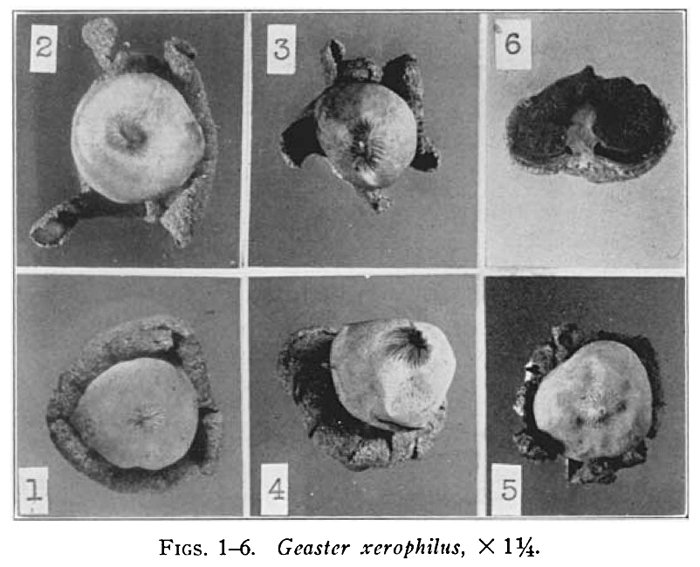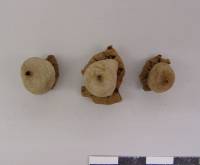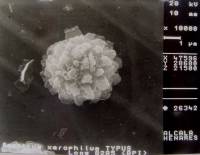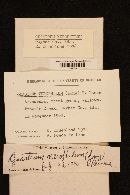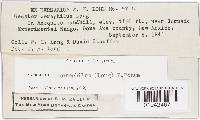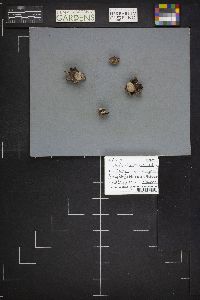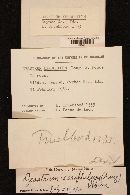Geastrum xerophilum
|
|
|
|
Family: Geastraceae
|
Geaster xerophilius Long: Long, W.H. 1942. Studies in the Gasteromycetes: IV. A new species of Geaster. Mycologia 34: 13-16. Â Â Â Â Â Sporophore hypogeous, small, the button subglobose to strongly depressed-globose or rarely concave on top, 1-2 cm. across, having a strong basal mycelial cord, becoming superficial and expanded at maturity then 1-4 cm. in diameter, usual size about 2 cm. Exoperidium saccate (FIG. 1) to explanate (FIG. 2, 3), split to about the middle or rarely to the center in old weathered plants; rays 7-12, pliable, not hygroscopic, unequal, blunt (FIG. 2, 3), tardily expanded or with the tips involute (FIG. 4, 5) around the endoperidium; fleshy layer cream buff to cinnamon color(*) adnate, continuous, rarely rimose; exterior covered with sand held by the persistent, thin, strongly adnate mycelial layer which even in very old weathered plants is still retained; base concave with a prominent umbilical scar. Endoperidium subsessile to usually short-pedicellate, subglobose to strongly depressed-globose, often flattened on top (watch-shaped), 1-2 cm. across, light buff to drab gray when fresh, becoming pallid mouse gray to pale cartridge buff (whitish) with age, densely and minutely furfuraceous (but not asperate), lower 1/3 often enclosed by the saccate base of the exoperidium. Peristome small, circular or sometimes elliptic (FIG. 2, 3), acute, sulcate with 18-30 sulci of unequal thickness and length, some not extending to apex of peristome, not seated in a depressed area, concolorous or rarely darker, in age often becoming expanded into a gaping mouth (FIG. 4). Gleba mummy brown when fresh becoming snuff brown with age; columella prominent (FIG. 6), cylindrical, expanding at top into a persistent globose mass of hyphae; capillitium simple, snuff brown under the microscope,4-4.5 microns thick. Spores globose, 1-guttulate, 4.2-5 microns in diameter, semi-opaque in water mountant; epispore chestnut brown, coarsely verrucose. HABITAT:Â Â Â Â Â Solitary or in small groups of 2 or 3 plants, in open, sandy areas or rarely in partial shade of desert plants; in hot dry regions. DISTRIBUTION:New Mexico, Dona Ana County, Jornado Experimental Range, elevation 4150 feet, Ivan H. Crowell, February 6, 1937-2 plants no. 8078: Ivan H. Crowell, W.H. Long and Victor O. Sandberg, May 2, 1937-2 plants no. 8182: W.H. Long, June 6, 1938-3 plants no. 9295; November 12, 1938-8 plants no. 8285 Type and 4 plants no. 8281; October 2, 1939-7 plants nos. 8400, 8772 and 9378. Lincoln County, 25 miles northwest of Corona, elevation 7100 feet, W.H. Long and David J. Stouffer, April 20, 1940-2 plants no. 9289. Bernalillo County, near Albuquerque, elevation 5000 feet, W.H. Long, June 25, 26 and 27, 1941-6 plants nos. 9362, 9368 and 9370. Sandoval County, 5 1/2 miles west of San Ysidro, elevation 6250 feet, W.H. Long, July 9, 1941-19 plants nos. 9379 and 9380; 2 miles south of the town of Bernalillo, elevation 5000 feet, July 12 and 17, 1941-10 plants nos. 9443 and 9453. A total of 63 plants collected to date (July 17, 1941). The above distribution of Geaster xerophilus shows a range extending from near Las Cruces in southern New Mexico northward 230 miles in the Rio Grande Valley to Albuquerque, thence southeastward 75 miles to near Corona, then northwestward 50 miles from Albuquerque on State Highway 44. The species probably occurs generally throughout the hot, semi-arid, sandy regions of New Mexico. NOTES:Geaster xerophilus is the only sulcate-mouthed Geaster which is saccate and has a pedicellate spore sac. G. archeri is also saccate and has a sulcate mouth, but its spore sac is sessile and not pedicellate.
     The xerophytic habit of Geaster xerophilus is unique in this genus. It develops some 1 to 2 inches below the surface of the sand, with little evidence of decaying vegetation or humus in the soil and usually without any shade. This growth habit is in marked contrast to that of the other species of Geaster found in the hot regions of the southwest where the writer has collected hundreds of plants of many different species all growing in the direct shade of trees or desert shrubs; however one species, G. mammosus, is often found in partial shade, apparently this species does not require much shade or leaf debris for its development.
|

